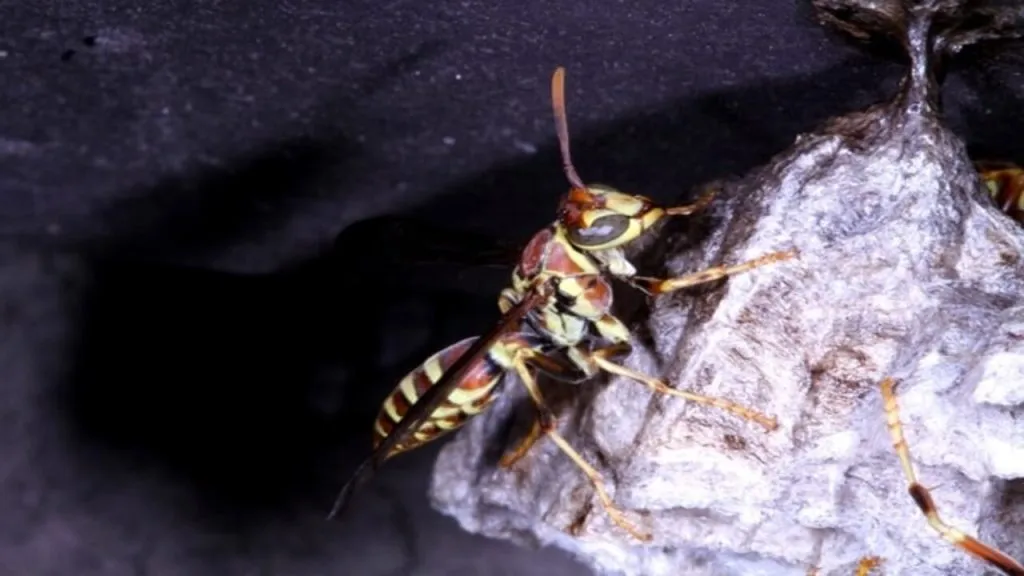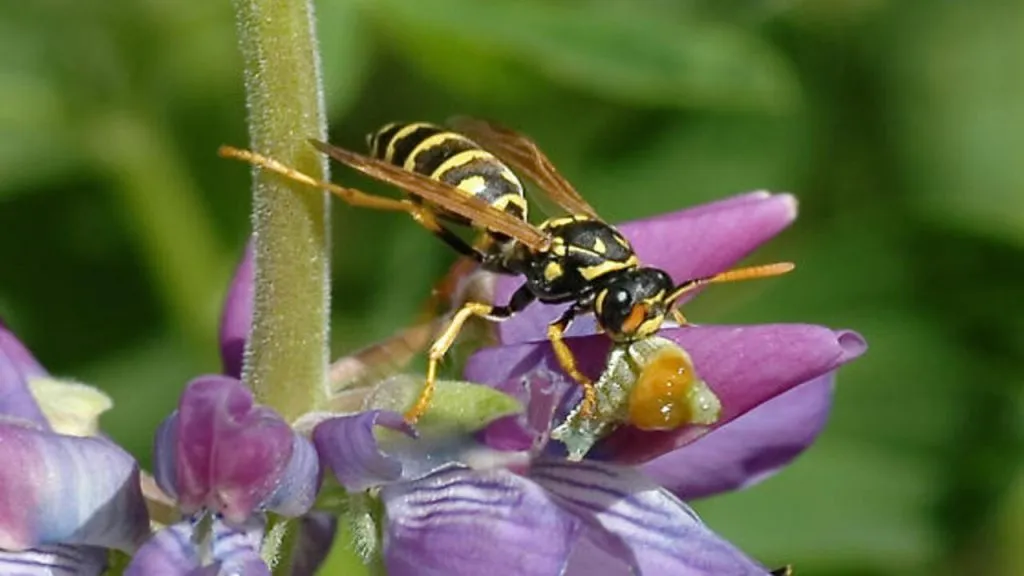As an Amazon Associate I earn from qualifying purchases.
The Paper wasp belongs to a group of insects called Hymenoptera and is part of the Vespidae family.
These insects are found all over the world except Antarctica. In North America, the most common type of paper wasp comes from the Polistes genus.
But what exactly do paper wasps like to eat? We’ll find out more about that soon in the next section.
There are different kinds of paper wasps, but they all have similar traits.
They’re usually small bugs, about 1 to 2 inches long, with slim bodies, long legs, and narrow waists.
Their bodies are often reddish-brown or black with yellow or orange markings.
Paper wasps build nests using materials that look like paper, which is how they got their name.
You’ll often spot these nests in protected areas like under roof eaves or among bushes.
These nests are where the paper wasp colony lives, and there can be quite a few wasps in one colony.
Understanding what they eat helps us understand their role in nature and how they behave.
In this blog post, we’ll talk about what paper wasps eat and how To Control Paper Wasps.
And also learn about how they hunt and what baby paper wasps like to eat. So, let’s get started!
What do Paper Wasps Eat All Year Round?

Paper wasps are adaptable eaters, meaning their food preferences change depending on the time of year, where they are, and how their colonies are growing.
They’re mostly meat-eaters and go after a variety of bugs like caterpillars (which are especially loved by young wasps), flies, spiders, aphids, ants, moths, and other insects with soft bodies.
These bugs are important because they give adult wasps the protein they need to stay healthy, and they also feed their growing larvae.
Aside from bugs, paper wasps also like to sip on flower nectar. They visit flowers often to get this sweet liquid, which gives them the energy they need to fly around and stay busy.
Sometimes, when they find ripe fruits like berries, melons, or apples, they’ll have a taste.
They might even enjoy fruits that are a little past their prime, getting some extra nutrients and sugars from the juicy bits.
Occasionally, when other food is hard to find, paper wasps might scavenge for things like dead animals or insects.
They’re not too picky when they’re hungry and need some extra nutrients.
Plus, they might also snack on honeydew, which is a sugary liquid made by bugs like aphids and scale insects that feed on plants.
It’s worth mentioning that what a paper wasp eats can change based on its species, the time of year, and what food is around.
Knowing all the different things they eat helps us see how paper wasps play a big role in nature.
They help keep bug numbers in check, make sure plants get pollinated, and help recycle nutrients in ecosystems.
This shows how vital they are to keeping things balanced in nature.
What do European Paper Wasps Eat?
European Paper Wasps have quite a diverse diet, mainly consisting of different insects and nectar. Their favorite meal? Caterpillars!
They’re like small, effective pest controllers, making sure there aren’t too many caterpillars around.
But they’re not picky eaters—they’ll also snack on other soft-bodied bugs like flies and beetle larvae to add variety to their diet.
Now, when it comes to the adults, they’re more into a vegetarian lifestyle, or more accurately, they love nectar.
They enjoy sipping on the sweet nectar from flowers, which gives them the energy they need to fly around and take care of their nests.
Sometimes, they might even treat themselves to honeydew, a sugary liquid made by aphids.
All in all, European Paper Wasps are important for keeping insect populations balanced and also help out with pollination when they visit flowers for nectar.
What do Northern Paper Wasps Eat?
Northern paper wasps are like European paper wasps. They like eating caterpillars.
Sometimes, they also eat other soft insects like flies, beetles, and grasshoppers.
They do this to have different kinds of food.
So, both European and Northern paper wasps eat insects and nectar to stay healthy as they grow up.
What do Baby Paper Wasps Eat?
Baby paper wasps, which we call larvae, mainly eat insects, which are full of protein.
The adult paper wasps, including the worker wasps, go out and catch all sorts of bugs like caterpillars, flies, spiders, aphids, and other little insects.
They bring these bugs back to the nest and chew them up into tiny pieces to feed the growing larvae.
Caterpillars are especially liked by baby paper wasps because they’re packed with protein, which helps the young wasps grow big and strong.
The grown-up paper wasps make sure the larvae always have enough of these chewed-up bugs to eat.
This protein-rich diet helps the larvae grow quickly and change into adult wasps.
So, in short, baby paper wasps eat lots of chewed-up bugs that the adult wasps bring back to the nest.
Caterpillars are their favorite because they’re full of good stuff that helps them grow up healthy and strong.
How do Paper Wasps Find Their Food?

Paper wasps are pretty clever when it comes to finding food. They have really good eyesight, so they can see things from far away.
They’re especially good at noticing movement and colors, which helps them find things like caterpillars hiding in leaves.
Some types of paper wasps, like the European ones, are attracted to bright colors.
Sometimes they mistake colorful clothes or picnic tablecloths for flowers and might fly over to check them out, thinking they’ll find nectar there.
Paper wasps also have a sense of smell that helps them find food. They can sniff out scents from things like caterpillar poop or the chemicals released by aphids.
These wasps are also pretty smart. They can learn from what they’ve seen before and remember where they found food in the past. So, they can go back to those spots and find more food.
Sometimes, they even leave a smell behind on their food to help them find it again later or show other wasps where it is.
And in some types of wasps, they use dances to tell their buddies where to find food. It’s sort of like the dances honeybees do to show where the flowers are.
How To Control Paper Wasps?
Controlling paper wasps can be important if they’re building nests near where people live or work, even though they help control pests.
If you’re dealing with paper wasps around your area, here are some simple tips to help you manage them:
1. Cover Food and Garbage Properly
- Paper wasps are attracted to sweet stuff like ripe fruit and sugary substances. Cover up your fruit trees or bushes to keep the ripe fruit out of reach.
- Make sure your garbage cans are tightly closed to stop the wasps from getting into the trash.
2. Remove Standing Water
- Paper wasps like water, so get rid of any standing water on your property. That means things like bird baths, pet bowls, and flower pots that collect water should go.
3. Trim Trees and Shrubs
- Cutting back trees and shrubs can help lower the number of paper wasps around. Caterpillars, which paper wasps like to eat, often hang out on trees and shrubs.
- Trimming these plants can make it harder for the caterpillars to get to the leaves and branches.
4. Consider Using Insecticide
- If you’re dealing with a lot of paper wasps, insecticides might help. There are different kinds available, so it’s a good idea to talk to an expert about which one would work best for your situation.
Remember, paper wasps are useful bugs that help keep pests in check. But if they’re too close to where people are, they can become a bother.
What Eats Paper Wasps?
Paper wasps are a type of wasp that’s famous for making nests out of paper. You can often find these nests in trees or buildings, and they can get pretty big.
Usually, paper wasp colonies are peaceful, but if they feel like their nest is in danger, they’ll defend it.
Because paper wasps like to build nests near where people live, folks often wonder what animals eat them.
Lots of creatures snack on paper wasps. Birds are one of the main ones—they might eat the wasps themselves or tear apart the nests to get to the baby wasps inside.
Small animals like mice and bats might also munch on paper wasps, and some spiders are experts at catching them.
Sometimes, other insects, like certain bees, might even parasitize paper wasps.
Even though paper wasps have their fair share of enemies, they’re still doing okay as a species.
Wrapping Up
In conclusion, paper wasps are beneficial insects that help control pests. However, they can become a nuisance if their nests are built near areas where people live or work.
If you have paper wasps in your area, it is important to know what eats them and how to control them. Thanks for reading!
FAQ’s:
Paper wasps go through four main stages in their life cycle: egg, larva, pupa, and adult.
It starts when the queen lays eggs in cells within the nest.
These eggs hatch into larvae, which are fed by the adult wasps with chewed-up insects.
As they grow, the larvae spin cocoons and enter the pupal stage. Eventually, they emerge as adult wasps.
The newly emerged females become workers and help build the nest, feed the larvae, and protect the colony.
Towards the end of the season, some larvae develop into new queens and males, which mate and start the cycle over again.
There’s no clear evidence that wasps remember individual human faces like we do.
They were more focused on finding food, building nests, and taking care of their colonies.
However, they do have good memory skills when it comes to locations and finding food sources they’ve visited before.
In the winter, paper wasps face a scarcity of food due to the cold weather. They enter a state of dormancy or hibernation called diapause.
During this time, they consume stored reserves of fat and rely on stored nectar or honeydew.
Some wasps may also scavenge for food if it’s available, but their activity is greatly reduced compared to warmer months.
The most aggressive wasp species can vary depending on factors like location and environmental conditions.
Generally, species like yellow jackets and hornets are known for their aggressive behavior, especially when defending their nests.
However, aggressiveness can also depend on the individual wasp’s temperament and the circumstances they encounter.
It’s essential to give these insects space and avoid disturbing their nests to prevent stings.
Amazon and the Amazon logo are trademarks of Amazon.com, Inc, or its affiliates.

